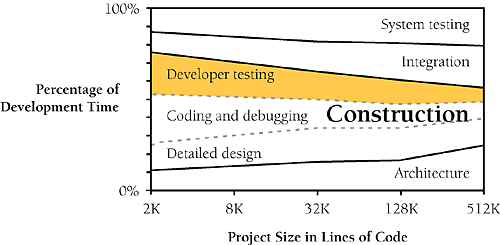22.1. Role of Developer Testing in Software Quality
| < Free Open Study > |
| Testing is an important part of any software-quality program, and in many cases it's the only part. This is unfortunate, because collaborative development practices in their various forms have been shown to find a higher percentage of errors than testing does, and they cost less than half as much per error found as testing does (Card 1987, Russell 1991, Kaplan 1995). Individual testing steps (unit test, component test, and integration test) typically find less than 50 percent of the errors present each. The combination of testing steps often finds less than 60 percent of the errors present (Jones 1998). Cross-Reference For details on reviews, see Chapter 21, "Collaborative Construction."
If you were to list a set of software-development activities on "Sesame Street" and ask, "Which of these things is not like the others?" the answer would be "Testing." Testing is a hard activity for most developers to swallow for several reasons:
A key question is, How much time should be spent in developer testing on a typical project? A commonly cited figure for all testing is 50 percent of the time spent on the project, but that's misleading. First, that particular figure combines testing and debugging; testing alone takes less time. Second, that figure represents the amount of time that's typically spent rather than the time that should be spent. Third, the figure includes independent testing as well as developer testing. As Figure 22-1 shows, depending on the project's size and complexity, developer testing should probably take 8 to 25 percent of the total project time. This is consistent with much of the data that has been reported. Figure 22-1. As the size of the project increases, developer testing consumes a smaller percentage of the total development time. The effects of program size are described in more detail in Chapter 27, "How Program Size Affects Construction." A second question is, What do you do with the results of developer testing? Most immediately, you can use the results to assess the reliability of the product under development. Even if you never correct the defects that testing finds, testing describes how reliable the software is. Another use for the results is that they can and usually do guide corrections to the software. Finally, over time, the record of defects found through testing helps reveal the kinds of errors that are most common. You can use this information to select appropriate training classes, direct future technical review activities, and design future test cases. Testing During ConstructionThe big, wide world of testing sometimes ignores the subject of this chapter: "white-box" or "glass-box" testing. You generally want to design a class to be a black box a user of the class won't have to look past the interface to know what the class does. In testing the class, however, it's advantageous to treat it as a glass box, to look at the internal source code of the class as well as its inputs and outputs. If you know what's inside the box, you can test the class more thoroughly. Of course, you also have the same blind spots in testing the class that you had in writing it, and so black-box testing has advantages too. During construction, you generally write a routine or class, check it mentally, and then review it or test it. Regardless of your integration or system-testing strategy, you should test each unit thoroughly before you combine it with any others. If you're writing several routines, you should test them one at a time. Routines aren't really any easier to test individually, but they're much easier to debug. If you throw several untested routines together at once and find an error, any of the several routines might be guilty. If you add one routine at a time to a collection of previously tested routines, you know that any new errors are the result of the new routine or of interactions with the new routine. The debugging job is easier. Collaborative construction practices have many strengths to offer that testing can't match. But part of the problem with testing is that testing often isn't performed as well as it could be. A developer can perform hundreds of tests and still achieve only partial code coverage. A feeling of good test coverage doesn't mean that actual test coverage is adequate. An understanding of basic test concepts can support better testing and raise testing's effectiveness. |
| < Free Open Study > |
EAN: 2147483647
Pages: 334
 Testing requires you to assume that you'll find errors in your code. If you assume you won't, you probably won't, but only because you'll have set up a self-fulfilling prophecy. If you execute the program hoping that it won't have any errors, it will be too easy to overlook the errors you find. In a study that has become a classic, Glenford Myers had a group of experienced programmers test a program with 15 known defects. The average programmer found only 5 of the 15 errors. The best found only 9. The main source of undetected errors was that erroneous output was not examined carefully enough. The errors were visible, but the programmers didn't notice them (Myers 1978).
Testing requires you to assume that you'll find errors in your code. If you assume you won't, you probably won't, but only because you'll have set up a self-fulfilling prophecy. If you execute the program hoping that it won't have any errors, it will be too easy to overlook the errors you find. In a study that has become a classic, Glenford Myers had a group of experienced programmers test a program with 15 known defects. The average programmer found only 5 of the 15 errors. The best found only 9. The main source of undetected errors was that erroneous output was not examined carefully enough. The errors were visible, but the programmers didn't notice them (Myers 1978).